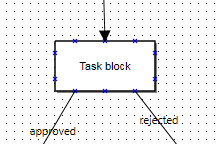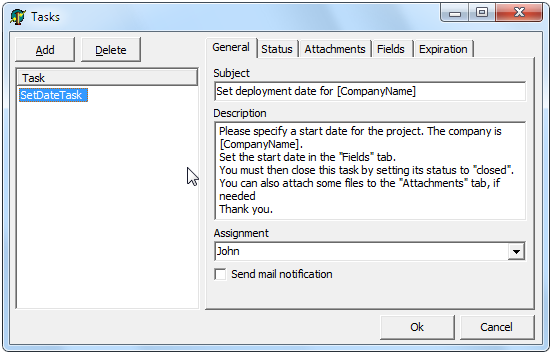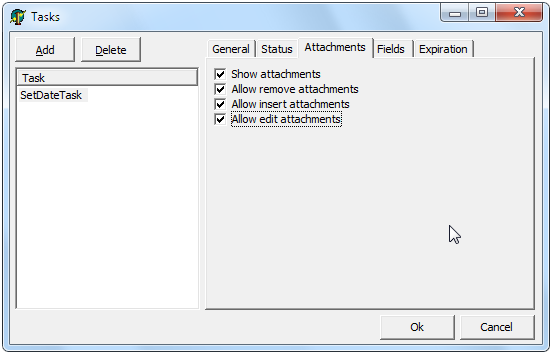
This Help topic refers
to the following editions:
þ Enterprise þ
Professional þ
Small Business
A task definition specifies a task to be created for a user. It's not the running task itself, but a specification for the task. If a workflow is already running, changing a task definition will not change the workflow. Only new workflows will use the changes made to the task definition.
In the task definition you specify the subject, task name, description, the user, a list of valid status, and other properties. A task definition is always "inside" a workflow definition. One of the actions you can define in a workflow definition is generating tasks, and the task definition is part of the action specification.
The task definition appears in the Diagram Designer as below:

For example, in a workflow definition for order processing, you might want
to create a task for the manager to approve the order. To change the task
definition block in the Diagram Designer, double click the task block.
In this case, the task definition would be something like this:
Subject: Order approval
Description: Please approve the order [OrderNo]
User: Manager
Valid Status: Waiting approval, approved, rejected
The General tab will be filled out as below:

The General tab contains the following areas:
Subject - The title of the task, which will appear in the task list. Usually, the subject is a categorization of the type of task being executed, such as "Approval". Workflow variables can be called and displayed dynamically in the Subject field.
Description - The details of the task that give the user instructions for what must be done for this task to be completed appropriately. Workflow variables can be called and displayed dynamically in the Description field.
Assignment - The user or group of users that will have this task assigned to them. Workflow variables can define the user or group that should be called. The Task Group Assignment Mode defined in Home | Options | Administrator | Workflow Settings defined the default behavior for all workflows. By add the word "all" or "any" before the a group over rights this default behavior:
Adding "All(Your Group Name)" will create one task for each member in the group to handle.
Adding "Any(Your Group Name)" will create a single task for any member in the group to handle.
Send mail notification - Check this box if you would like an e-mail to be sent to the Assigned User when the task instance becomes active.
The Status tab will be filled out as below:

The Status tab contains the following areas:
Add - Click to add a new status to the end of the Status list.
Delete - Click to delete the highlighted status from the Status list.
Status list - The statuses that have been created for this task definition. The statuses that are marked as Completion will be in bold.
Status name - The name of the status that the end user will select to apply that status to the task.
Completion - Check the completion check box if you would like the task to be considered done once it reaches this status. Only a completion status will allow workflow to continue past the task. The status will decide the path the workflow will continue in after the task by following the transition arrow associated with that status in the workflow definition.
Hidden - If you would like to hide the status from the end users, so that they cannot manually select the status for the task. For example, you may want an expiration status to be hidden so it is not selected inadvertently by an end user.
The attachment tab is displayed here:

The Attachments tab sets the permissions users assigned to a task will have to show, remove, insert, or edit attachments.
Show attachments: Check if the user assigned to this task instance should be able to see what attachments are appended to the workflow instance.
Allow remove attachments: Check if the user assigned to this task instance should be able to remove attachments from the workflow instance.
Allow insert attachments: Check if the user assigned to this task instance should be able to insert new attachments from the workflow instance.
Allow edit attachments: Check if the user assigned to this task instance should be able to make changes to attachments from the workflow instance.
The Fields tab is shown as below:

The Fields tab will allow the task to have variables available to the user, where they can view or change the variable values to use for your business logic.
Add: Click "Add" to add a variable to the fIelds tab in the task list view, where users will be able to enter values during their execution of the task.
Delete: Click "Delete" when a variable is highlighted to delete it from the list.
Variables: List of the variables created for this task definition.
Text Caption: The label the user will see next to the field variable, which will tell them what data needs to be input or is being displayed.
Workflow variable: Each variable in the fields tab is not connected globally to the workflow, unless there is a selection made in this dropdown. The task instance will connect to the workflow variable in the workflow instance depending on what is selected here.
Editor Type: The type of input allowed by the end user. Choose from Text, Check (check box), Date, Memo (long text field), or Dropdown. When Dropdown is selected, there icon will become selectable. Click the item to add items to your dropdown list by adding each item on a new line in the box that appears.
Read Only: Users will not be able to make changes to the field.
Required: Users must enter a value for this field before saving the task.
Multiple Tasks
The task block also allows multiple tasks to be in the block. To add a new task to the block, click the Add button in the top left. You can configure the additional tasks in the same way the first task was configured by selecting the new task in the left pane and using the tabs mentioned above.
**Additional tasks will not allow the workflow to route in a different direction than the completion status of the first task. These tasks can be used for modifying variables, or to have other work completed before the workflow is completed. The workflow will not complete until all tasks have been completed, but the direction of the workflow will be only determined by the completion status reached by the first task in the list.